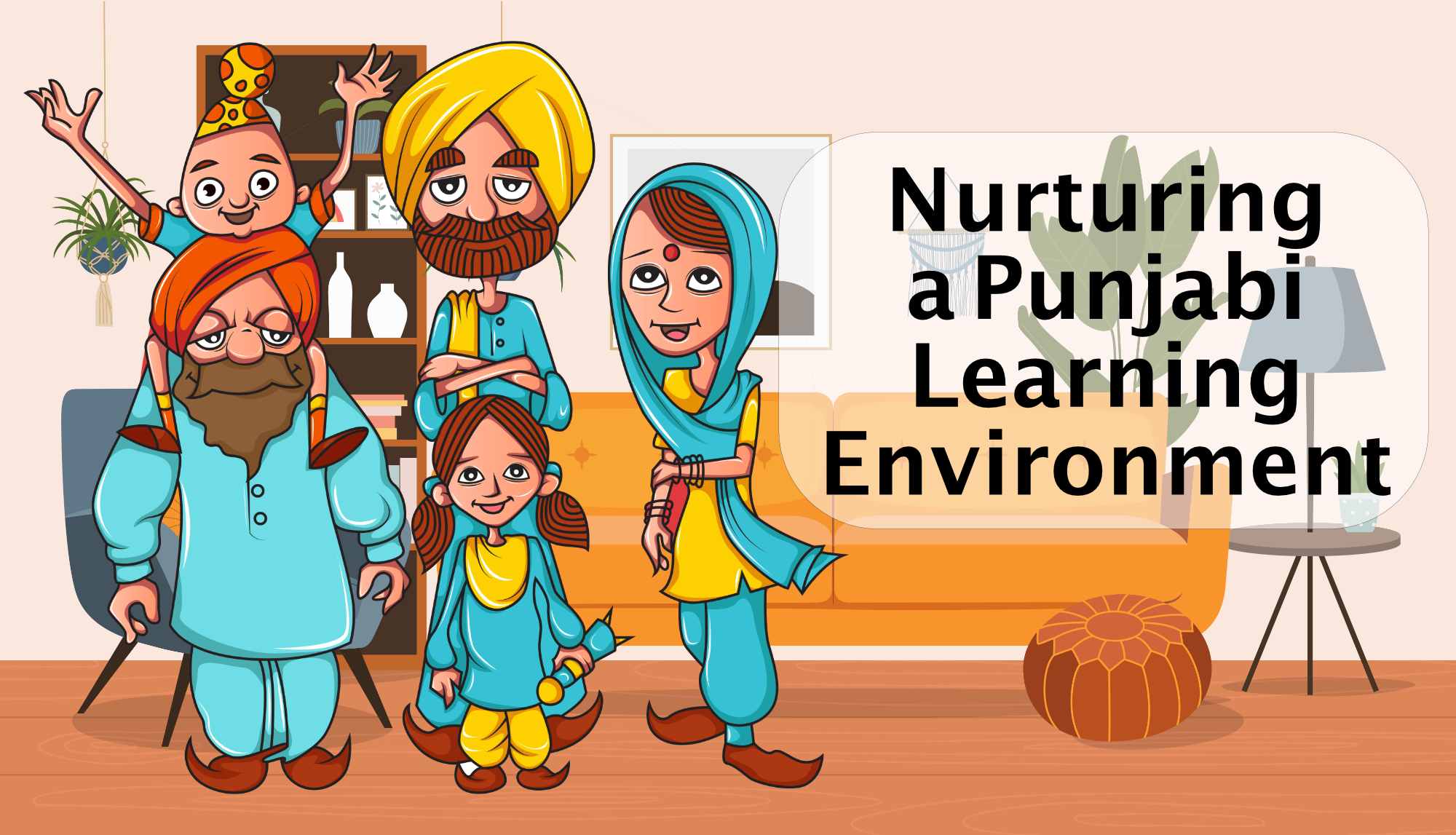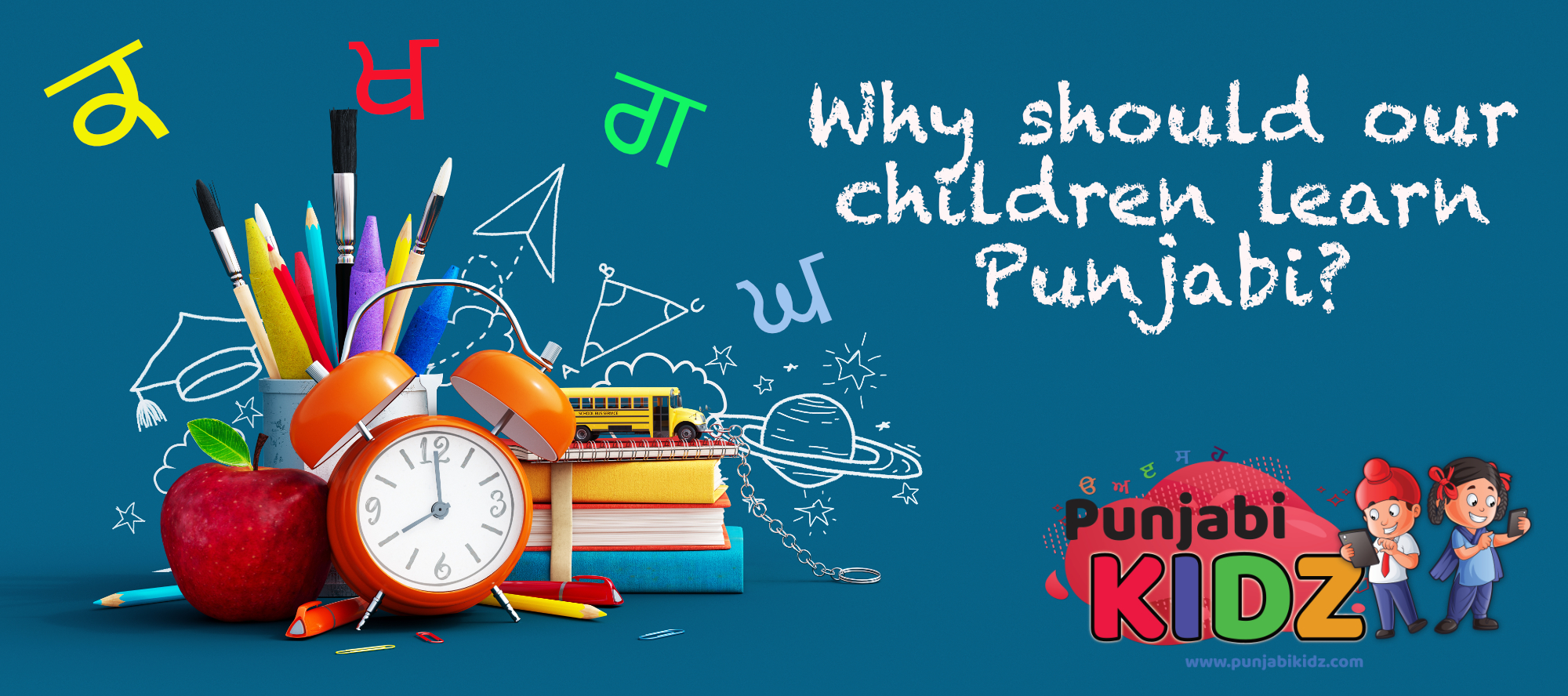Nurturing our Roots: Encouraging Punjabi Language Learning in our Children
In today’s globalizing world, many of us, particularly those from Sikh and Punjabi backgrounds, find ourselves raising our children in environments far different from where we grew up. Living in English-speaking countries provides our children with a multitude of opportunities and experiences. However, it also presents a challenge to us, as Punjabi Sikh parents, to preserve our cultural heritage, including the language and traditions, within our homes and in our children’s lives.
Punjabi is generally the widely spoken language of Sikh scripture and tradition which connects us deeply to our faith and roots. Punjabi is also the language that echoes in our Gurudwaras and is intertwined with our rituals, prayers, and community gatherings. Its preservation is integral not only to our identity but also to the ongoing vitality of Sikhism and Punjabi culture.
In this blog post, our goal is to inspire you to cultivate the learning of Punjabi in your children’s lives, especially if they are not initially Punjabi speakers. We will explore the enriching benefits of bilingualism, offer tips on how to incorporate Punjabi learning into their everyday routine, and introduce the resources available on our website that will support you in this enriching journey. Together, let’s ensure that our children grow up with a strong connection to their Punjabi Sikh heritage while thriving in their multicultural surroundings.
Why Punjabi?
Punjabi, a vibrant and expressive language, is central to our cultural identity and is written using the gurmukhi alphabet. Punjabi is a language spoken in India, particularly in the state of Punjab, permeating our music, folk tales, and family interactions. The act of speaking Punjabi allows us to maintain a deep connection to our roots, our traditions, and to the cultural landscape of Punjab province in India, regardless of our geographical location in the world. More than just a means of communication, our native language of Punjabi carries with it the legacy of our ancestors, the aroma of our homeland, and the soulful depth of our traditions. Engaging with Punjabi provides a sense of home and familiarity, creating a profound connection between us, our heritage, and our community.
Learning standard Punjabi also enables our children to cultivate cognitive flexibility, creativity, and a broader perspective of the world. This goes hand in hand with developing their English language skills, and together, these bilingual capabilities can shape their identities and broaden their horizons in extraordinary ways.
Benefits of Bilingualism
Bilingualism offers an array of benefits that extend beyond communication. Studies have shown that children who are bilingual often excel in problem-solving, creativity, and multitasking, as managing two languages trains the brain to process information more efficiently. Additionally, being bilingual deepens cultural understanding, enabling children to connect more profoundly with diverse communities. It also provides increased career opportunities in our globally interconnected world and may even offer long-term health benefits by delaying cognitive aging. In essence, fostering bilingualism in children’s lives can significantly enrich their cognitive, cultural, and professional futures. For our children, punjabi as their mother tongue can form an intimate connection to their cultural heritage and community through language, enriching their multicultural experiences and perspectives.
Challenges of Raising Bilingual Children in English-Dominant Societies
When embarking on the journey of raising bilingual children in an English-dominant society, there are several challenges that parents often face. Understanding these hurdles is the first step towards effectively navigating them and developing a sustainable bilingual environment for your child.
Language in the World and Preference for English: One of the primary challenges is the natural gravitation of children towards the language of the majority. Schools, media, peers, and the surrounding environment mostly use English, which can lead children to prefer it over Punjabi. They might find it ‘easier’ or ‘cooler’, potentially leading to a reluctance to learn or use Punjabi.
Limited Exposure and Practice: Unlike English, opportunities to use Punjabi in everyday life, especially outside the home, can be limited. Without consistent exposure and usage, language skills can stagnate or even diminish, especially so with those who do not speak punjabi .
Lack of Resources: While Punjabi is written typically with Gurmukhi alphabet, it has been influenced by Sanskrit, which can pose a unique challenge for children learning the language due to the complex and distinct nature of Sanskrit script and grammar rules. Finding high-quality, engaging resources to teach Punjabi can be a hurdle. Traditional methods may not resonate with the younger generation who are accustomed to interactive, digital learning tools.
Preserving Cultural Connections: Language is deeply tied to culture. As children become more assimilated into their surrounding English-speaking environment, maintaining the cultural connection associated with punjabi people can become difficult.
Societal Pressure and Misconceptions: There may be external pressures or misconceptions about bilingualism, such as the myth that learning two languages can cause confusion or delay in children. Despite evidence to the contrary, such views can create doubts and anxiety for parents.
Each of these challenges presents a significant hurdle, but none are insurmountable. In the following sections, we will explore how to leverage our online platform to address these issues and foster a love of the Punjabi language in your children. The key lies in consistent exposure, making learning fun and relevant, and demonstrating to our children the richness and value of our modern Punjabi.
Understanding the challenges of fostering Punjabi language learning in an English-dominant environment, our online platform has been developed to be a comprehensive resource for both you and your children. It provides a variety of engaging and interactive Punjabi learning materials that are not just educational but also fun.
Using Online Learning Platforms
In response to the challenges of fostering bilingualism in English-dominant societies, we’ve created a comprehensive and engaging tool for learning Punjabi – PunjabKidz.com. Designed with modern educational approaches and a deep understanding of the needs of young learners, our platform is here to support parents and children alike on their journey to learn the way the language is spoken and write punjabi while building their vocabulary of Punjabi.
Another reason for children’s reluctance to learn Punjabi is the fear of failure. Children may be afraid of making mistakes and may avoid learning Punjabi out of fear of embarrassment or judgment.
Despite these challenges, it is important for children to learn Punjabi as it can help them connect with their cultural heritage, improve their job prospects, and gain a deeper understanding of Punjabi culture. By understanding the reasons behind children’s reluctance to learn Punjabi, we can work together to create a more supportive and motivating learning environment that encourages children to embrace this rich language.
What can Parents Do?
As a parent, you play a crucial role in supporting your child’s learning journey and helping them develop a love for the Punjabi language. Here are some ways that you can encourage your child to learn Punjabi:
Make it fun:
Make learning the Gurmukhi script an engaging experience for the child. This will increase the likelihood that the child will be motivated to learn Punjabi language. Your child’s experience of learning Punjabi may be made more enjoyable and interesting by including a variety of interactive activities, such as games, songs, and other activities.
Encourage your kid:
Encourage your kid to ask questions, make errors, and to explore the language in their own unique way by creating an environment that is supportive of these activities. For youngsters, one of the most effective forms of motivation is to have a learning atmosphere that is upbeat and encouraging.
Incorporate Punjabi into your day-to-day life:
Motivate your child to employ the language in routine scenarios, like during meals or while partaking in family activities. Immersing in communities of Punjabi speakers can greatly bolster their speaking skills and build their confidence in using the language.They will be able to improve their speaking abilities and their confidence in the language as a result of this.
Use Multimedia Resources:
There are various resources accessible online and in print that may assist your child in learning Punjabi. Some examples of these resources are books, videos, and audio resources. Inspire your youngster to investigate all of these options and discover which ones they find most interesting.
At PunjabiKidz.com, we understand the importance of making learning Punjabi fun, engaging, and accessible for children. That’s why we have created a web portal filled with a wide range of educational resources designed to help children learn Punjabi in a fun and interactive way.
Connect with the Punjabi community:
Engage in the rich heritage of Punjabi in India and participate in the Sikhs by going to cultural events, temple and gathering with other families who share your interest in the continuation of the Punjabi language and culture. Your child will have an easier time seeing the value and relevance of learning Punjabi as a result of this, and the experience will have greater significance overall as he/she interacts with speakers of punjabi.
Lead by example:
Children are typically more likely to be motivated to study when they witness their parents engaged in the learning process themselves. Therefore, it is important for parents to provide a good example for their children. Demonstrate to your kid that you appreciate the Punjabi language and culture by picking up the language with them and making an effort to use it in your day-to-day life.
Be patient:
Remember that learning a new language is a process that requires both time and effort on your part. Inspire your child to keep at it and be proud of whatever progress they make, no matter how insignificant it may seem.
Conclusion
In conclusion, you may assist your kid in developing a passion for the Punjabi language and becoming a confident and skilled speaker of this significant language by implementing these tactics into your child’s educational experience. We believe that by offering a comprehensive and accessible e-learning experience, we can help children develop a lifelong love of learning and a deep connection to the Punjabi language and culture. So if you’re looking for a fun and effective way to help your child learn Punjabi, look no further than PunjabiKidz.com!







